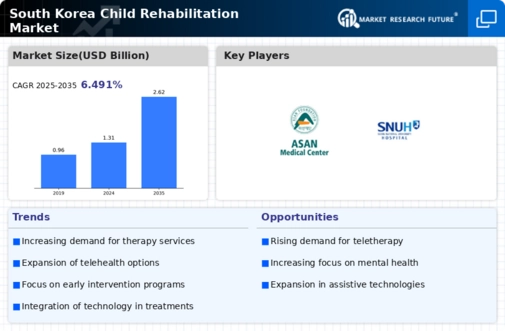Supportive Policy Framework
A supportive policy framework is crucial for the growth of the child rehabilitation market in South Korea. The government has implemented various policies aimed at improving the quality and accessibility of rehabilitation services for children. Initiatives such as increased funding for rehabilitation programs and the establishment of national guidelines for best practices are likely to enhance service delivery. Recent government reports indicate that funding for child rehabilitation services has increased by 20% over the past two years, reflecting a commitment to improving outcomes for children in need. This supportive environment may encourage private sector investment and innovation within the child rehabilitation market, ultimately leading to enhanced service offerings and better outcomes for children.
Growing Emphasis on Mental Health
The growing emphasis on mental health in South Korea is emerging as a pivotal driver for the child rehabilitation market. As societal attitudes shift towards recognizing the importance of mental well-being, there is an increasing demand for services that address psychological and emotional challenges faced by children. The child rehabilitation market is likely to benefit from this trend, as parents seek comprehensive care that includes mental health support. Recent surveys indicate that nearly 30% of parents express concerns about their children's mental health, which may lead to a surge in demand for integrated rehabilitation services. This focus on mental health not only enhances the scope of rehabilitation programs but also encourages collaboration between mental health professionals and rehabilitation specialists.
Increased Accessibility to Services
Accessibility to rehabilitation services is a crucial factor influencing the child rehabilitation market. In South Korea, the government has been working to enhance the availability of services through various initiatives, including the establishment of more rehabilitation centers and mobile therapy units. This expansion is particularly vital in rural areas, where access to specialized care has historically been limited. Recent data suggests that the number of rehabilitation facilities has increased by approximately 15% in the last three years, indicating a positive trend towards greater service availability. As accessibility improves, more families are likely to seek out rehabilitation services, thereby driving growth in the child rehabilitation market. This trend may also encourage the development of community-based programs that provide support and resources to families.
Advancements in Rehabilitation Techniques
Innovations in rehabilitation techniques and methodologies are transforming the child rehabilitation market in South Korea. The integration of evidence-based practices, such as cognitive-behavioral therapy and play therapy, is becoming more prevalent. These advancements not only improve therapeutic outcomes but also attract families seeking effective solutions for their children. The market is projected to grow at a CAGR of around 8% over the next five years, driven by these advancements. Additionally, the introduction of personalized therapy plans tailored to individual needs is likely to enhance engagement and efficacy. As practitioners adopt new technologies and approaches, the overall quality of care in the child rehabilitation market is expected to improve, thereby increasing its appeal to parents and guardians.
Rising Awareness of Developmental Disorders
The increasing awareness of developmental disorders among parents and educators in South Korea appears to be a significant driver for the child rehabilitation market. As more families recognize the signs of conditions such as autism spectrum disorder and attention deficit hyperactivity disorder, the demand for specialized rehabilitation services is likely to rise. Reports indicate that approximately 1 in 38 children in South Korea are diagnosed with autism, which underscores the necessity for effective rehabilitation programs. This heightened awareness is fostering a culture where early intervention is prioritized, thereby propelling the growth of the child rehabilitation market. Furthermore, educational institutions are increasingly collaborating with rehabilitation centers to provide comprehensive support, which may further enhance service accessibility and effectiveness.

















Leave a Comment